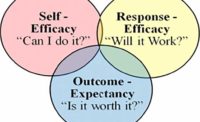Training - loosen up
Did you ever think about how your style as a safety trainer can encourage either mindlessness or mindfulness? Dr. Langer made this case: When facts are presented unconditionally as an absolute truth, alternative ways of thinking about something are stifled. She backed this up with an interesting study. A collection of objects was introduced in an ordinary, unconditional way to one group, as for example, "This is a dog's chew toy." For the second group, objects were introduced conditionally with the extra phrase "could be," as in, "This could be a dog's chew toy."After the objects were introduced, the groups were asked to complete some survey forms. Then the experimenter announced that the survey could not continue because the wrong instructions had been given and no spare forms were available. Several subjects suggested, though, that the rubber chew toy could be used as an eraser to correct the flawed forms. Interestingly, this resourceful idea came only from the conditional group, those told, "This could be a dog's chew toy."
Do you discuss safety rules as unconditional mandates? Or do you focus on safety principles that imply certain guidelines but can be customized? It's obvious which approach stimulates more creativity and ownership among individuals and work teams.
The uncertainty of the second approach allows people to use their minds in figuring out how to adapt a safety principle for a particular situation. In turn, they feel like they own the solution they came up with, and they will be committed to mindfully follow the personalized procedures.
Leadership - let your guard down
Here's a related way to promote innovation and initiative: As a leader, display a degree of "uncertainty." Dr. Langer suggests that a leader should show confidence that a particular job will get done, but without being certain of the best way to do it. Again, this allows employees room to be mindfully alert, creative, and self-motivated. Workers are less afraid to make mistakes, and more willing to suggest ways to improve a process.As a safety leader, you should confidently expect employees to take appropriate precautions to prevent injuries. But you shouldn't pretend to know exactly how they should do this. After all, employees are the real safety experts. They know what hazards need to be eliminated or avoided, and what safety-related behaviors need to occur more or less often. Most likely, they are also effective at encouraging safe behaviors and discouraging at-risk behaviors. I hope you see how a leadership quality of "confident uncertainty" can empower workers to go beyond the call of duty for safety and health.
Teamwork - note the differences
We tend to give global labels to people-student, patient, homosexual, union representative, safety professional, athlete or homeless person. Each label influences how we view people, judge them, and react to their communication with us. You can see the affect this can have on teamwork, which often makes or breaks safety efforts. Mindless labeling, or premature cognitive commitment(see last month's article), leads to stereotyping, prejudice, interpersonal conflict, and sometimes even hate crimes.Now here's a twist: Dr. Langer suggests the key to reducing prejudice is to make more-not fewer-distinctions between people. When people become more mindful of the many differences among individuals, and how these differences can vary according to time, place, and the people involved, it becomes harder to stick labels on people. It becomes impossible to view people and their behavior as black or white, normal or abnormal, masculine or feminine, safe or unsafe.
In this case, an employee should not be labeled "safe" or "unsafe" at a particular job. It helps teamwork and overall safety efforts to realize each person works at their own level of safety, and that level can fluctuate dramatically from one situation to another.
Involvement - give 'em a choice
The degree of personal control you give people helps determine their level of participation in efforts to improve workplace safety and health. People mindful of having personal control are more likely to actively care.In a seminal study, Dr. Langer and her colleagues gave one group of elderly residents in a Connecticut nursing home the opportunity to care for a houseplant and to make a number of minor decisions about their daily routines. A year and a half later, these residents were more cheerful, alert, and active than a similar group who were not given these choices. The most remarkable result: less than half as many of the residents in the "choice group" had died compared to those in the other group.
Dr. Langer suggests we can be more motivated to take charge by becoming more mindful of the many choices we actually make during ordinary activities. What time we get up in the morning, what we wear, what we eat for breakfast, how we get to work-there are alternatives and options for all of these routine, almost mindless decisions. Becoming more mindful of how we shape our days can increase our perception of personal control, and our motivation. You can apply the same thinking to even the most routine jobs, and people can become more mindful of actions and attitudes that could be safer, more useful, and more productive.
Understanding mindful versus mindless behavior has many benefits. It gives us insight into individual perceptions and interpersonal conflict. When we listen to conversation based on mindless labeling, or see mindless behavior, we understand how it leads to nonproductive relationships and at-risk behaviors. By diagnosing a situation more accurately we can develop an effective intervention process. At the very least, we become more aware of our own mindlessness and can begin work on changing ourselves. You can always build on awareness, on mindful activity.
By E. Scott Geller, Ph.D., senior partner, Safety Performance Solutions, and professor of psychology, Virginia Tech. For information on related books, training manuals, videotapes, audiotapes, and customized consulting, call SPS at (540) 951-7233 (SAFE), and visit www.safetyperformance.com.
Sidebar 1 -
Be Mindful Of... 1 Using conditional rather than unconditional statements when training, assigning jobs, or stating expectations;
2 Showing confidence as a leader but displaying some degree of uncertainty regarding exactly how a job should be safely completed;
3 Making more distinctions between individuals and avoiding global categorization of people and events; and
4 Becoming more mindful of our daily choices we so often take for granted.
Sidebar 2 -
Benefits Of Being Mindful
- People mindful of having personal control are more likely to actively care and be involved.
- Teamwork and overall safety is helped when you realize each person works at their own level of safety.
- Leaders who exhibit "confident uncertainty" can empower workers to come up with their own solutions for safety and health.
- Focusing on safety principles that can be customized instead of mandates allows employees to take the initiative and ownership of processes.

